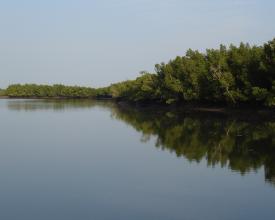
Mangrove conservation, climate change and food security
Full Solution

Mangroves at Rio Cacheu
Pierre Campredon
Sea level rise makes it necessary to raise the dikes of rice fields. However, indigenous people of Guinea-Bissau lack employment, and tend to leave the rice fields. The initiative focuses on helping to restore rice fields and mangroves that were once abandoned. A set of alternative activities (fishing, tourism) and conservation measures complement this shared governance model.
Context
Challenges addressed
Mangrove degradation due to rice cultivation, human/wildlife conflict, loss of knowledge
Beneficiaries
Local communities, Fisheries Ministry, Ministry of Education, tourism operators, national NGOs.
Location
Guinea Bissau
West and Central Africa
Impacts
A participatory spatial planning approach involving the local population has helped to identify the rice field areas to maintain, as well as the formerly cultivated areas that are now dedicated to the restoration of mangroves. Some rice growing areas threatened by sea level rise were recovered through the raising of the dikes.
In return, part of the mangrove was recovered with the help of the population, which had impacts on fisheries resources and biodiversity.
The shared governance approach was extended to other aspects of the protected area management and community development (fisheries, tourism, conservation, education, monitoring). This pioneer approach has been replicated in other protected areas of the country.




